Accepted Scientific Name: Cycas furfuracea W.Fitzg.
J. Proc. Roy. Soc. Western Australia 3: 108 (1918)
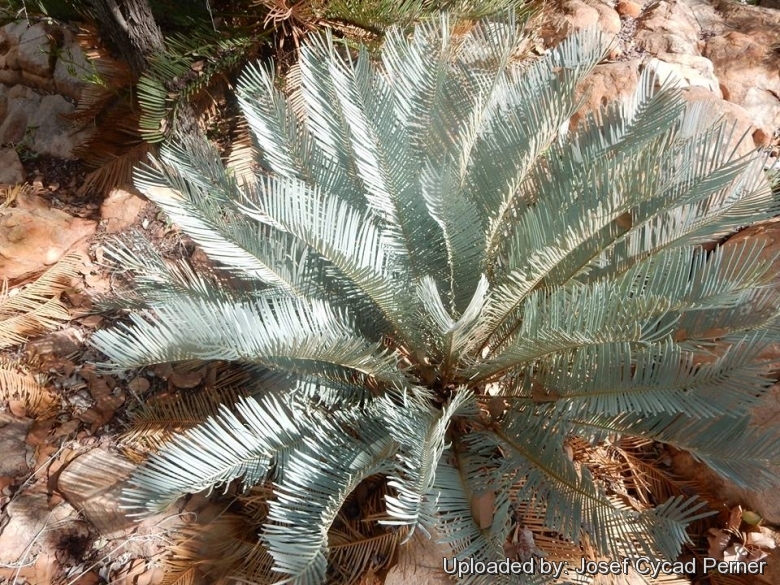
Cycas media var. furfuracea (Cycas furfuracea) Photo by: Josef Cycad Perner
These Cycas furfuracea plants flush green and turn blue as leaves mature.
Origin and Habitat: Cycas furfuraceaSN|28248]]SN|28248]] is a sporadic species in rather an isolated section of the King Leopold Ranges in the Kimberley region of Western Australia. Subpopulations are known mainly from elevated parts of the King Leopold Range, with another occurrence on Kimbolton and on islands to the north of there, such as Heywood Island.
Altitude range: 250 to 300 metres above sea level.
Habitat and Ecology: C. furfuracea is a fairly widespread and relatively common species usually found on skeletal sandy soils on hard siliceous metasandstone, on steep slopes, and also on red clay on rocky basalt outcrops, often along gullies and near creek systems. Occurs in dry woodlands. The population is relatively large and stable and there are no threats to this species. This species inaccessibility has been its protection so far.
Synonyms:
Description: Cycas furfuraceaSN|31800]]SN|28248]] is a dioecious, palm-like plant with a simple stout trunk distinguished by the strongly keeled leaves with angled, broad, often white-tomentose, glaucous leaflets with slightly recurved margins. Some plants sucker around their base. The specific name means covered with loose scales and this appertains to the underside of the leaf fronds which are conspicuously so.
Trunk (caudex): Quite thick (somewhat like forms of Cycas mediaSN|28248]]SN|31800]]) measuring from 1 m to perhaps 2.5(-4) metres in height and 18-22 cm in diameter at narrowest point.
Leaves (fronds): (50-)80-100(-150) cm in length, held stiffly and slightly curving out from the apex. Rhachis glabrous. Pinnae numerous (appros100-220 on each rachis) leaflets inserted at 40-70° on rachis, entire or rarely bifid, broad, linear, rigid and straight, (70-)100-150(-200) mm in length 40-60-(75) mm in width, decurrent for 3-7 mm, narrowed to 4.5-6 mm at base, and strongly keeled with darker tips 9-13 mm apart on rachis. The fronds are consistently terminated by paired leaflets, and leaflets gradually reduce in size to grade into spines on a short petiole. Petiole 15-26 cm long, pubescent. Margins somewhat recurved. Apex acute, spinescent. Midrib prominent.The leaf colour above is an intense glabrous blue with grey-white tomentum persistent in the underside. Sporadic individuals also lack the glaucous leaf wax, leading to the occasional occurrence of green plants.
Cataphylls: Linear, soft, hairy, not caducous.
Microsporangiate (male) cones: Approximately 30-40 cm long and 6-7 cm wide, orange to brown, narrow and ovoid with a pointed end. Microsporophyll firm, 30-40 mm long, 16-20 mm wide, fertile zone 20-25 mm long, sterile apex 12-18 mm long, deflexed, apical spine prominen.Soft grey hairs cover the cones.
Femal cones: Simple. Megasporophylls approximately 15-20(-36) cm long. The blades of the megsporophylls are prominently arranged with soft flexible spine-like teeth above the ovules and terminating in a blunt end. The entire cone structure is covered with brown woolly hair. The ovules, when mature, being 2.5 cm long, yellow with adhering grey tomentum.
Seed: Heavily powdered, flattened-ovoid, 32-36 mm long, 27-32 mm wide, sarcotesta orange-brown, strongly pruinose, 2-3 mm thick; fibrous layer absent; sclerotesta smooth. Spongy endocarp absent.
Bibliography: Major references and further lectures
1) Hill, K.D. 2010. Cycas furfuracea. The IUCN Red List of Threatened Species. Version 2014.2. <www.iucnredlist.org>. Downloaded on 29 July 2014.
2) The Cycad Pages © 1998-2012 Royal Botanic Gardens Sydney Written and maintained by Ken Hill 1998-2010 [http://plantnet.rbgsyd.nsw.gov.au/cgi-bin/cycadpg?taxname=Cycas+furfuracea] Downloaded on 29 Jul. 2014.
3) Whitelock, Loran M., “The Cycads” Timber press, 2002, ISBN 0-88192-522-5.
4) Haynes J.L, “World List of Cycads: A Historical Review” IUCN/SSC Cycad Specialist Group, 2012.
5) L. P. Butt “Palms & Cycads” No. 27, Apr-Jun 1990.
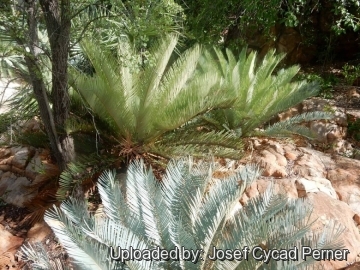 These Cycas furfuracea plants flush green and turn blue as leaves mature. (Cycas furfuracea) Photo by: Josef Cycad Perner
These Cycas furfuracea plants flush green and turn blue as leaves mature. (Cycas furfuracea) Photo by: Josef Cycad Perner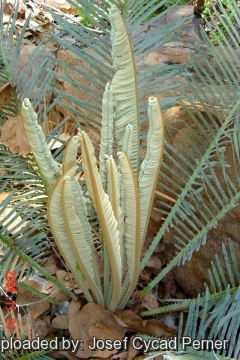 Cycas furfuracea. Bold Bluff. New leaf flush. (Cycas furfuracea) Photo by: Josef Cycad Perner
Cycas furfuracea. Bold Bluff. New leaf flush. (Cycas furfuracea) Photo by: Josef Cycad Perner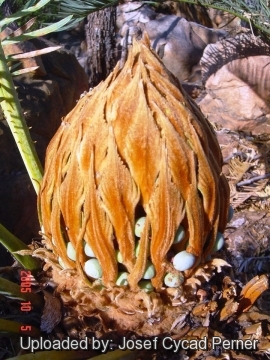 Cycas furfuracea in Ex-situ Conservation collection at Jurassic Cycad Gardens (Cycas furfuracea) Photo by: Josef Cycad Perner
Cycas furfuracea in Ex-situ Conservation collection at Jurassic Cycad Gardens (Cycas furfuracea) Photo by: Josef Cycad Perner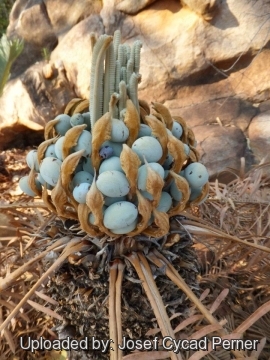 Cycas furfuracea, Cone Bay. Viable seeds. (Cycas furfuracea) Photo by: Josef Cycad Perner
Cycas furfuracea, Cone Bay. Viable seeds. (Cycas furfuracea) Photo by: Josef Cycad Perner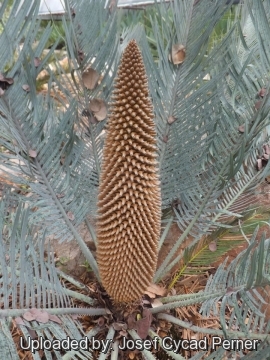 Cycas furfuracea. Male cone. (Cycas furfuracea) Photo by: Josef Cycad Perner
Cycas furfuracea. Male cone. (Cycas furfuracea) Photo by: Josef Cycad Perner Cycas furfuracea. Male cone, microsporophylls. (Cycas furfuracea) Photo by: Josef Cycad Perner
Cycas furfuracea. Male cone, microsporophylls. (Cycas furfuracea) Photo by: Josef Cycad Perner 35 year old Cycas furfuracea. This is in a 30 cm pot. At Cycad International. (Cycas furfuracea) Photo by: Josef Cycad Perner
35 year old Cycas furfuracea. This is in a 30 cm pot. At Cycad International. (Cycas furfuracea) Photo by: Josef Cycad Perner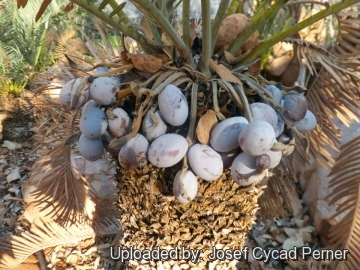 Mature seeds. (Cycas furfuracea) Photo by: Josef Cycad Perner
Mature seeds. (Cycas furfuracea) Photo by: Josef Cycad PernerCultivation and Propagation: Cycas furfuraceaSN|28248]]SN|28248]] is suited to tropical regions which have a seasonally dry climate. It is easy to grow, tolerating dry periods.
Growth rate: Usually slow growing, however good conditions can speed it up considerably. Because of its growth habit, fertilize only when terminal bud begins to swell, indicating the start of the annual growth cycle.
Exposure: It prefers bright light exposure but colour bleaches when in full sun; best with some protection from afternoon heat.
Soil: Needs a well drained spot, with deep soil, but will still thrive in less than ideal conditions.
Maintenance: Minimal; removal of offsets if desired, removal of spent fronds.
Use: Landscape as cultivated perennial in warm, coastal areas; House-plant or interior-scape, as container plant in cool areas, as well very well suited to bonsai culture.
Propagation: Seed or offshoots (or "pups" ). The advantage of the "pups" is that you will know its sex, for seedlings you will have to wait several years until the plant flowers to find out. After fertile seeds are collected, they usually need several months of storage before the inner embryo is ready to germinate. Therefore, it is best to clean the seeds of external fruit and set them aside before attempting to propagate the seeds.
Your Photos

by Josef Cycad Perner

by Josef Cycad Perner

by Josef Cycad Perner

by Josef Cycad Perner

by Josef Cycad Perner






















